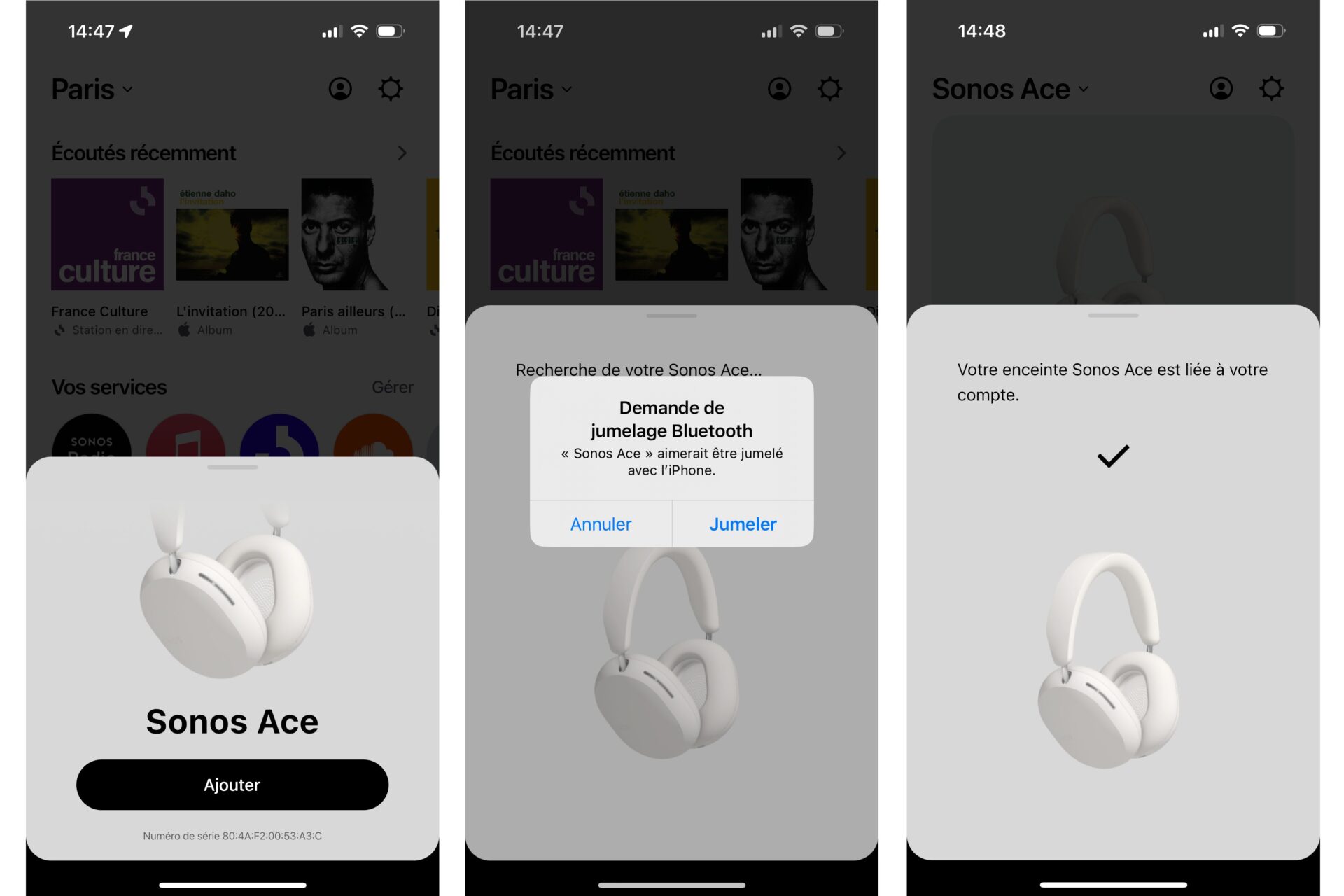This is certainly one of the most anticipated audio products in recent years. For what ? Because Sonos often shows that it has a certain know-how for these speakers and that designing a helmet looks like a significant step forward for the brand. A much larger market than multiroom audio, the problem addressed by most of its products.
Therefore, the Californian manufacturer has no real room for error compared to other high-end models. Because at 500 euros, this first Ace is positioned precisely in this niche. Well above one of the market benchmarks, the Sony WH-1000XM5 (330 euros) and 100 euros more expensive than another, the helmet Bose QuietComfort Ultra (400 euros); which benefited from falling prices after their release. On the other hand, Sonos has made sure to stay under the untouchable AirPods Max (€580), logically it is he who should suffer the most from his competition, since the goal seems to be identical.

Beautiful, discreet, well finished
This is reflected in the design and build quality. First of all, Sonos is more sober than its compatriot, not looking for an overly stylish effect. All in roundness, it dares, except for that discreet slanted cutout at the bottom of either side of the headband and those grilles hiding the microphones and vents; chrome plated and clearly visible. A hinge placed in the earpiece prevents hair from getting caught.

The plastics used are matte and designed to resist fingerprints, successfully. Only a slightly shiny Sonos logo gives away the brand of the headphones. The assembly is simply flawless and exudes quality. The quality of the materials used is also felt in the padding: dual-density foam for the headband and memory foam for the ear cushions.

Suffice it to say that its weight, while a substantial 312 grams, (250 grams for Sony or Bose for example) is not felt at all. We wore this helmet for hours without ever wanting to take it off. The internal size of the headphones allows them to be placed on the ears without imposing any restriction. The lid is level, hard and felt covered, very pleasant to use and fits the helmet flat. Inside is a small removable pouch that allows you to fit the two supplied cables (USB-C to USB-C and USB-C to 3.5mm jack).

Comfortable and ergonomic
Another good point, the pads and their inner protective grid are beautifully fixed and therefore can be easily replaced in case of wear. This does not apply to the battery, which will require you to go through a partner service to do so; but at least it will be technically possible. Despite this very integrated design, the Ace doesn’t benefit from any IP certification, just that Sonos engineers assured us that we’ll be able to play sports with it, but certainly not in the rain. The fault lies in those vents hidden under the grilles, which necessarily let liquids through.

Therefore, the first contact is very qualitative, but this is the minimum we expected from a headset costing 500 euros. For controls, Sonos has opted for all physical and touchless. This is not unpleasant for us when we work blindly like a helmet. At the very bottom of the left earcup is the power and Bluetooth pairing button. On the back right, the one that controls the switch between noise reduction and transparency mode. Just above, the button offers several functions: by pressing it, you control play/pause or hang up/pick up in case of a call. Pressing up or down controls the volume. Everything fits perfectly under your thumb and you never mess up. And there’s a good point there.
The new Sonos app built for it
For the rest of the settings, the Sonos app needs to be launched – the new version, so much criticized at launch, but essential to the Ace. Bluetooth pairing is offered automatically when you launch the app with headphones on.

After this manipulation is performed, it appears in the System Settings section. There you can control noise management, equalization (bass, treble, balance, volume), head tracking, home theater functions, Bluetooth multipoint or even port detection. This is a very complete customization worthy of a high-end model.

Also in the app you can pair the headphones to your Arc soundbar. This Sonos-exclusive system lets you switch the signal from the speaker to the headphones simply by pressing and holding the main button. The connection is then established via point-to-point Wi-Fi between the two devices. Currently only compatible with this model, the Ace will soon be compatible with both Beam and Ray generations. Meanwhile, it works perfectly with Arc, as we’ve seen. Switching takes place in two seconds and allows you, for example, to continue watching a movie without disturbing the person next to you.

TrueCinema mode is not available at startup
Compatible with Dolby Atmos and head tracking, the Ace lets you continue to benefit from spatial audio. And with transparency mode, you can’t isolate yourself from the other people in the room if you want to. It’s a shame, though, that Sonos didn’t make TrueCinema mode available at the launch of its headphones; it will be available later with no date set for now. Like TruePlay, which adapts the manufacturer’s speaker equalization to the room it’s in, TrueCinema reproduces the room’s acoustics in the Ace headphones. A way to make switching between the two devices even more transparent. We’ll obviously be curious to test this when the manufacturer finally makes it available. 
So far, we’ve mainly taken the opportunity to thoroughly test the headphones’ musical audio qualities. Let’s start with the insulation, which is simply excellent. The foams in the ear pads already provide very good passive isolation, but the active reduction is also up to the task; almost up to what is offered by the kings of the genre that are Bose and Sony. The only slight downside is that the microphones are slightly sensitive to wind and you can sometimes hear the noise it causes. Another downside to the microphones is that they’re placed under the earcups, which can rub against your jacket collar when transparent mode is enabled, wherever you’re on a phone call. A harmful ergonomic flaw because both functions are excellent. The quality of the microphones is very real and allows you to simulate a very realistic transparency that takes into account the position of objects around you (you can hear a car coming from the right for example). Same thing with phone calls, the beam forming does its job very well and captures the voice perfectly. In addition, it is effectively isolated from background noise when it is present.

Warm and very flattering sound
On the component side, Sonos has built in 40mm diameter transducers. If not very specific about their design, the brand still details the compatible codecs: SBC, AAC and Snapdragon Sound (aptX Adaptive and aptX Lossless) for compatible Android smartphones. To enjoy lossless audio on an Apple device, you must use a wired connection via the included USB-C to USB-C cable (so Lightning devices require an adapter, which is not included). A small detail that is important, this cable is very short, not even 80 cm, and therefore impractical for daily use (the USB-C to jack cable exceeds 120 cm). Unfortunately, Sonos hasn’t yet enabled lossless decoding on our test model provided before official marketing, so we’ll come back to that usage later.

In Bluetooth, even limited to the first two codecs, we still managed to enjoy a well-designed sound quality, in the end very close to the usual signature of Sonos speakers. The whole thing is warm, well distributed, the bass is deep without being overwhelming, the midrange is extremely well presented and very flattering to voices. The most picky or fans of a more analytical sound may regret the slight lack of detail in the high frequencies and the impression that instruments are sometimes difficult to separate from each other. Nevertheless, we remain here at a level of quality worthy of a high-end model. For its first headphones, Sonos made no mistake and managed to integrate the recipe that is so popular with speakers.


